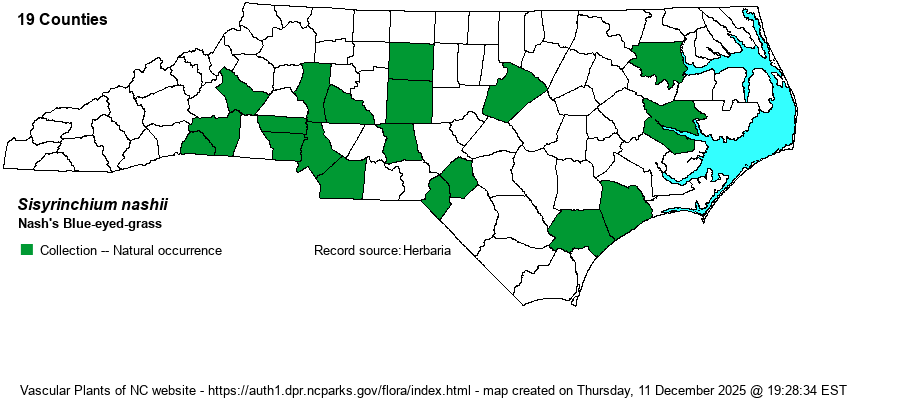| Author | Bicknell | |
| Distribution | Present over most of the southern and central Piedmont, and very widely scattered in the Coastal Plain. Absent from the Mountains, the extreme northwestern and northeastern corners of the Piedmont, and much of the Coastal Plain (where the range seems to be poorly clarified). It is not listed in RAB (1968), but the records in SERNEC indicate that older specimens (prior to about 1966), were identified as the common S. angustifolium. Later review of the specimens has determined that some are S. nashii, which was not considered as a valid species in NC at that time.
This is a Southern species, ranging from NC and TN (and possibly western VA) south to southern FL and MS. | |
| Abundance | Apparently not uncommon in the southwestern quarter of the Piedmont, but mostly absent to rare elsewhere in the province. Rare in the lower Coastal Plain. The species has certainly been under-collected, and seemingly the range should be connected between the lower Coastal Plain and the Piedmont. Not surprisingly, the NCNHP has not ranked it, and thus this website gives it a proposed State Rank of S3? | |
| Habitat | This species favors sunny and fairly dry habitats, a bit like other Sisyrinchium species. It occurs in fields, woodland edges, and roadbanks, among many other habitats. It can occur in somewhat moist grassy places, but normally in full sun. | |
| Phenology | Blooms from April into June, and fruits likely in May and June. | |
| Identification | This is a very tricky species to identify in the field, and a specimen likely will need to be collected and later measured (unless done with a hand lens in the field). It has a moderately wide stem, up to 3-4 mm (with the wings), as opposed to only 2 mm wide in S. fuscatum; and it is smooth on the stem margins (as opposed to rough in S. fuscatum). It has narrow basal leaves in a cluster, and the base of the plant has abundant brown fibrous remains of leaves. Otherwise, it has typical blue to light blue flowers that reach 0.5-0.6-inch across. To identify this in the field, you likely will need to see the abundant gray fibers at the base of the plants. There is still much to be learned about the identification and range of this blue-eyed-grass in the state.
| |
| Taxonomic Comments | This taxon has an odd history! There are many other old Sisyrinchium names used for it. However, the truth can be told from the labels on many of the specimens at the UNC Herbarium. In 1986, a number of the original S. angustifolium specimens were re-examined by K. Hornberger, and re-named as S. nashii. The mystery as to which map in RAB (1968) the S. nashii records were included has now been solved. (Note that S. angustifolium is found in probably every county in the state, and thus the dots delineating the range for S. nashii are not evident.)
| |
| Other Common Name(s) | None -- thankfully the only thing agreed on by botanists for this entity. | |
| State Rank | [S3?] * | |
| Global Rank | G4G5 | |
| State Status | | |
| US Status | | |
| USACE-agcp | FAC link |
| USACE-emp | FAC link |

